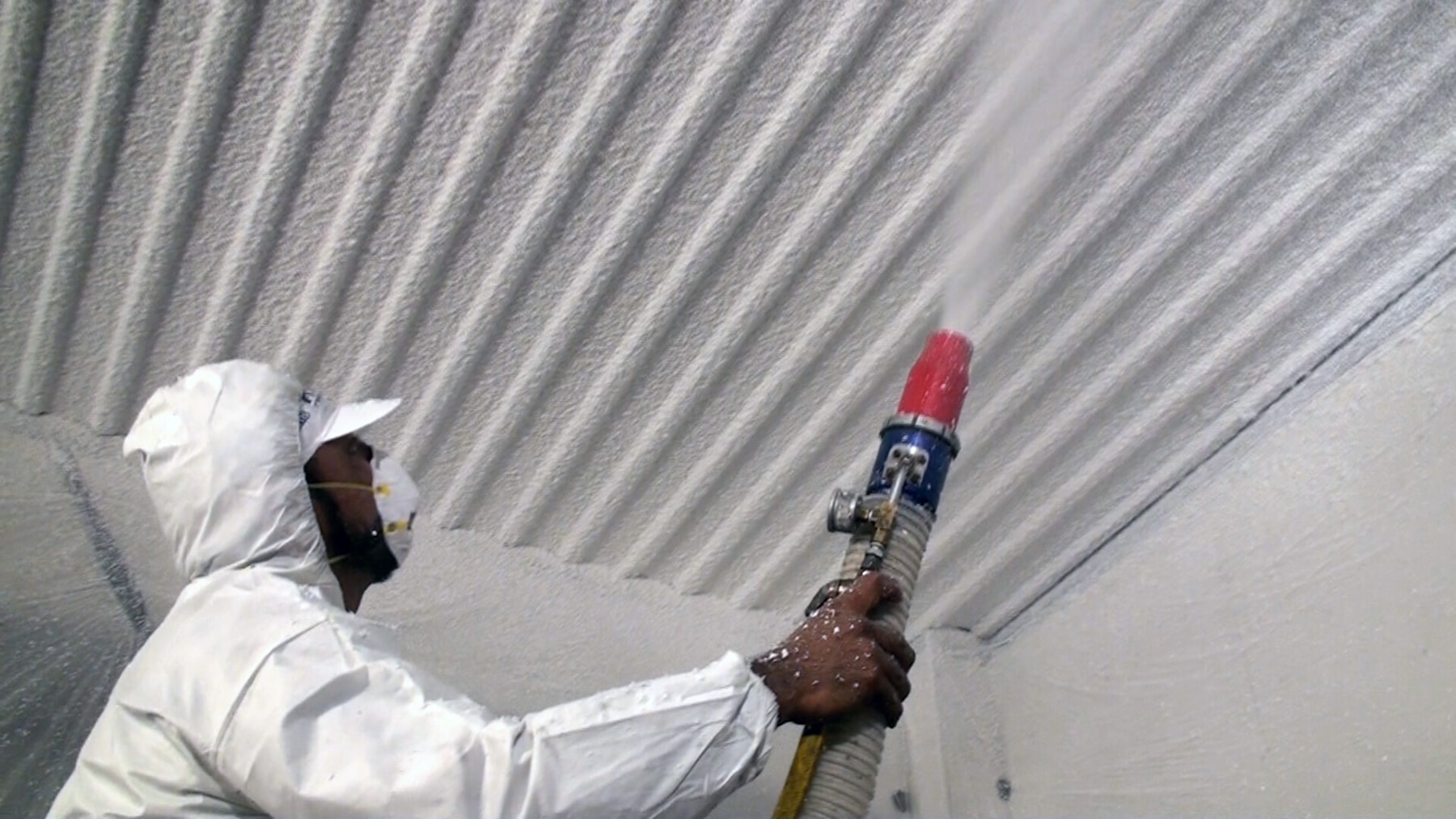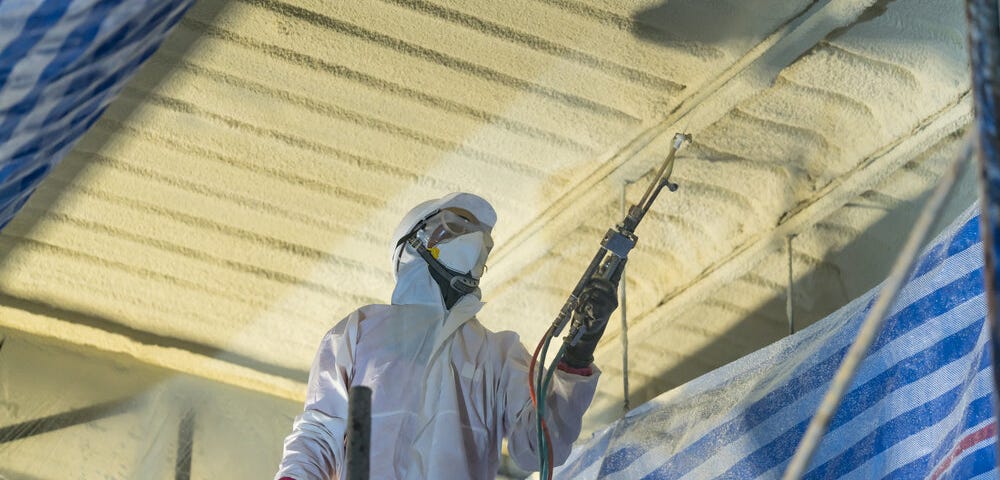Spray foam air barriers create continuous thermal boundaries that stop unwanted air movement and eliminate heat transfer through building envelopes. These systems achieve superior energy efficiency by sealing gaps, cracks, and penetrations that traditional insulation methods cannot address effectively. In Buhler’s climate, properly installed spray foam air barriers reduce heating and cooling costs by 30-50% while improving indoor comfort year-round.
This comprehensive guide examines spray foam air barrier technologies, installation methods, performance specifications, and decision factors for Buhler property owners seeking maximum energy efficiency and comfort control.
Understanding Air Barrier Performance Standards
Air barriers function as the primary defense against uncontrolled air movement through building assemblies. The International Energy Conservation Code defines air barriers as materials or systems that restrict air flow through building envelope components.
Spray foam air barriers outperform traditional methods because they expand to fill irregular spaces and create monolithic seals. This expansion property allows spray foam to address construction imperfections that compromise other air barrier materials.
Bonus Tip: Air leakage testing using blower door equipment helps quantify performance improvements and ensures proper installation quality.
Types of Spray Foam Air Barrier Systems
Open-Cell Spray Foam Systems
Open-cell spray foam creates effective air barriers while maintaining vapor permeability. These systems work well in climate zones where moisture management requires controlled vapor transmission.
| Characteristic | Open-Cell Performance |
| R-Value per inch | 3.5-4.0 |
| Air Permeability | 0.02-0.05 L/s·m² @ 75 Pa |
| Vapor Permeability | 16-50 perms |
| Density | 0.5-0.8 lb/ft³ |
| Cost per Square Foot | $1.50-$2.50 |
Closed-Cell Spray Foam Systems
Closed-cell spray foam provides superior air sealing with additional structural benefits. These systems create vapor barriers while delivering higher insulation values.
| Characteristic | Closed-Cell Performance |
| R-Value per inch | 6.0-7.0 |
| Air Permeability | <0.02 L/s·m² @ 75 Pa |
| Vapor Permeability | 0.8-1.5 perms |
| Density | 1.7-2.2 lb/ft³ |
| Cost per Square Foot | $2.50-$4.00 |
Installation Methods and Techniques
Surface Preparation Requirements
Proper surface preparation ensures optimal adhesion and performance. Surfaces must be clean, dry, and free from contaminants that prevent proper foam bonding.
Temperature and humidity conditions affect installation success. Substrate temperatures should remain between 40°F and 100°F during application, with relative humidity below 85%.
Application Thickness Standards
Air barrier effectiveness requires minimum thickness standards based on spray foam type and application location.
| Application Area | Open-Cell Minimum | Closed-Cell Minimum |
| Exterior Walls | 3 inches | 2 inches |
| Roof Assemblies | 5.5 inches | 3 inches |
| Basement Walls | 3 inches | 2 inches |
| Rim Joists | 3 inches | 1.5 inches |
Quality Control Measures
Professional installations require systematic quality control to ensure uniform coverage and proper thickness. Infrared thermography helps identify missed areas or thin spots that compromise air barrier performance.
Bonus Tip: Schedule inspections during installation to address issues immediately rather than discovering problems after completion.
Performance Benefits in Buhler’s Climate
Kansas experiences significant temperature variations that challenge building envelope performance. Summer temperatures regularly exceed 95°F while winter conditions drop below 20°F, creating substantial thermal stress.
According to the Kansas Corporation Commission, residential energy costs average $1,340 annually per household. Effective air barriers reduce these costs by minimizing heating and cooling loads.
Energy Efficiency Improvements
Spray foam air barriers deliver measurable energy savings through reduced air infiltration. The Department of Energy reports that air sealing can reduce energy consumption by 15% or more in existing buildings.
| Building Type | Annual Energy Savings | Payback Period |
| Single-Family Home | $400-$800 | 3-7 years |
| Multi-Family Building | $200-$400 per unit | 4-8 years |
| Commercial Building | $0.50-$1.25 per sq ft | 2-5 years |
Comfort Enhancement
Air barriers eliminate drafts and temperature variations that compromise indoor comfort. Consistent temperatures throughout conditioned spaces improve occupant satisfaction and reduce thermostat adjustments.

Things to Consider Before Making a Decision
Building Age and Construction Type
Older buildings often benefit more from spray foam air barriers due to construction methods that created numerous air leakage paths. Post-1980 construction typically has better initial air sealing but may still require targeted improvements.
Existing Insulation Conditions
Buildings with adequate insulation levels but poor air sealing represent ideal candidates for spray foam air barriers. Adding air sealing to well-insulated buildings maximizes energy efficiency investments.
Budget and Financing Options
Spray foam air barrier costs vary based on project size, access difficulty, and foam type selection. Many utility companies offer rebates for energy efficiency improvements that help offset initial investment costs.
Professional Installation Requirements
Spray foam installation requires specialized equipment, training, and safety protocols. Proper installation directly impacts performance and longevity, making contractor selection critical.
Bonus Tip: Request references from recent projects and verify contractor licensing and insurance coverage before making commitments.
Technical Specifications for Buhler Applications
Climate Zone Requirements
Buhler falls within Climate Zone 4A, requiring specific performance standards for air barrier systems.
| Performance Metric | Zone 4A Requirement | Spray Foam Achievement |
| Air Leakage Rate | ≤3.0 ACH50 | 0.5-1.5 ACH50 |
| Thermal Bridging | Minimize | Eliminated |
| Vapor Control | Moderate | Excellent |
| Durability | 25+ years | 50+ years |
Material Compatibility
Spray foam air barriers integrate with various building materials and systems. Compatibility testing ensures long-term performance without material degradation.
[Image: Cross-section diagram showing spray foam air barrier integration with different building materials]
Common Questions About Spray Foam Air Barriers
Installation Timeline
Most residential spray foam air barrier installations complete within 1-2 days, depending on project size and complexity. Commercial applications may require longer timeframes based on building size and access requirements.
Maintenance Requirements
Properly installed spray foam air barriers require minimal maintenance. Annual visual inspections help identify potential issues before they affect performance.
Fire Safety Considerations
Modern spray foam formulations include fire retardants that meet building code requirements. Thermal barriers may be required in certain applications to provide additional fire protection.
Indoor Air Quality Impact
Quality spray foam installations improve indoor air quality by reducing uncontrolled air infiltration that brings pollutants, allergens, and moisture into buildings.
Selecting Qualified Experts
Certification Requirements
Professional spray foam Experts maintain certifications from organizations like the Spray Polyurethane Foam Alliance (SPFA). These certifications demonstrate technical competency and commitment to industry standards.
Equipment and Safety Standards
Qualified Experts use commercial-grade equipment maintained according to manufacturer specifications. Safety protocols protect workers and building occupants during installation.
Warranty Coverage
Reputable Experts provide comprehensive warranties covering material defects and installation quality. Warranty terms typically range from 5-25 years depending on application type.
Frequently Asked Questions
How long does spray foam air barrier installation take? Most residential projects complete in 1-2 days, while commercial applications may require 3-5 days depending on building size and complexity.
What temperature conditions are required for installation? Substrate temperatures must remain between 40°F and 100°F with relative humidity below 85% for optimal spray foam performance.
Do spray foam air barriers require maintenance? Properly installed systems require minimal maintenance beyond annual visual inspections to identify potential damage or degradation.
How do spray foam air barriers compare to traditional air sealing methods? Spray foam creates continuous, monolithic seals that outperform traditional caulking and weatherstripping by addressing irregular spaces and construction imperfections.
What building codes apply to spray foam air barriers in Kansas? Kansas follows the International Energy Conservation Code with specific requirements for air leakage rates and thermal performance in Climate Zone 4A.
Ready to Achieve Superior Energy Efficiency
Spray foam air barriers deliver proven energy savings, enhanced comfort, and long-term durability for Buhler properties. These systems address air infiltration challenges that compromise traditional insulation performance while providing superior thermal control.
Transform your building’s energy efficiency with professional spray foam air barrier installation. Schedule your comprehensive energy assessment with Arma Coatings of Wichita to discover how spray foam solutions can reduce your energy costs and improve indoor comfort.
Contact Arma Coatings of Wichita today: (316) 779-2430 or [email protected] for expert consultation and professional installation services.
Reviewer: Charlotte King reviewed this article based on her 7 years of spray foam experience, contributing thoughtful advice about building customer relationships and improving local visibility.









